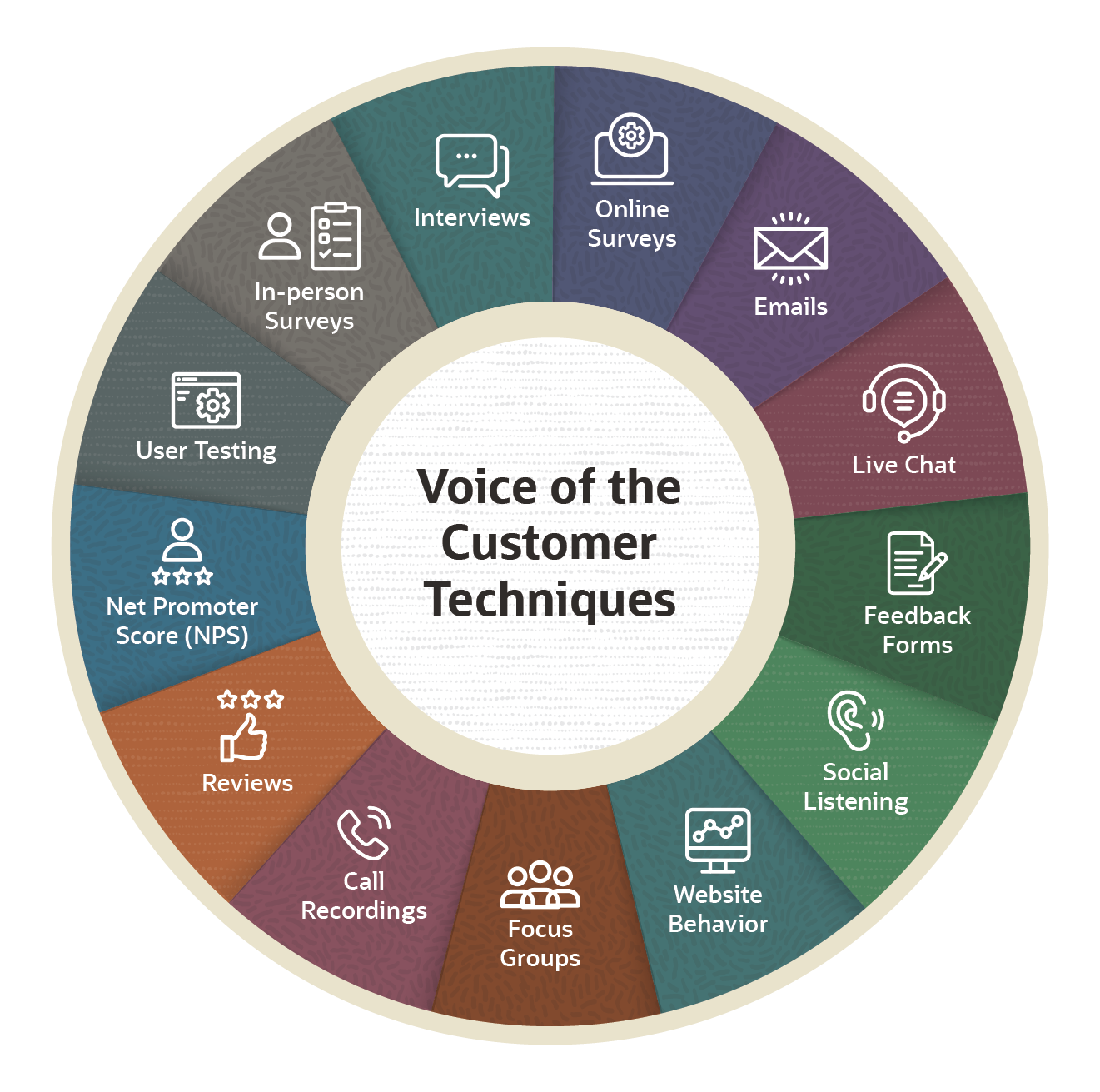To be successful, companies need to listen to their customers. What do they really want? What are their pain points? Voice of the customer (VoC) programs can help companies gain a deeper awareness of what their customers say and think. VoC involves collecting and analyzing feedback to reveal customers’ needs, expectations and preferences. Armed with these insights, companies can increase customer satisfaction and loyalty, which in turn leads to higher revenue and profitability. Here’s the scoop on the techniques, best practices and steps for building a successful VoC program.
What Is Voice of the Customer (VOC)?
“Voice of the customer” (VoC) describes the process of capturing customer feedback and using it to improve business processes and products. VoC programs aim to help companies better understand their customers’ needs and concerns; businesses can then tailor their goods and services to address those needs. Effective VoC programs blend a variety of methods for collecting and analyzing customer feedback, incorporating clearly defined goals and ways to proceed based on the insights gained. VoC programs have long relied on traditional techniques like surveys, customer interviews and focus groups, but, increasingly, they now may also include automated analysis of online content, such as social media comments and reviews.
Key Takeaways
- Voice of the customer programs collect and analyze user feedback to understand customers’ needs, expectations and preferences.
- VoC techniques include surveys, focus groups and analysis of online content, such as reviews and social media.
- Benefits of VoC programs include greater customer satisfaction, less customer churn and increased revenue.
Voice of Customer Explained
Understanding customer needs is a critical component of achieving sustained competitiveness. VoC programs help companies track customer satisfaction, preferences and concerns. By adjusting products and services in response to insights gained from VoC programs, businesses may be able to innovate faster than their competition. For example, VoC programs can help companies identify product deficiencies causing problems for customers, so those deficiencies can be addressed quickly in ways that generate increased revenue and profitability. Responding to customer feedback in this way can foster customer satisfaction and loyalty. Customer input can even help companies identify potential new products and services that will ultimately generate additional revenue.
13 Voice of Customer Techniques
Companies can choose from a wide and growing selection of VoC techniques, which include well-established methods, such as email surveys, focus groups, interviews and recorded customer-service calls, and tools to analyze user opinions expressed on third-party internet platforms, such as social media comments and online reviews. Combining multiple techniques can expand the reach of VoC programs and provide nuanced customer perspectives. Here are some of the most popular VoC techniques.
-
Online Surveys
Surveys are one of the most common ways to collect customer feedback. Online surveys help companies reach a large number of customers quickly and easily for detailed feedback on their experiences. Surveys commonly use multiple-choice questions, which generate quantitative data that can be easily tabulated and analyzed. Some surveys also let customers provide additional feedback in the form of unstructured text input.
One potential drawback is the overuse of surveys, which can lead to diminishing response rates. If surveys are too frequent or overly long and detailed, customers may view them as burdensome and fail to complete them. Some companies offer small incentives, such as gift cards or free downloads, to increase response rates.
-
Interviews
In-person interviews enable companies to obtain detailed, qualitative feedback from customers. Interviews may be highly structured, or they may use a more open-ended format. Depending on the structure of the interview and the skill of the interviewer, companies may be able to explore topics in depth and reveal issues that might not otherwise surface. For example, interviewers can ask follow-up questions that delve into customers’ specific problems or unusual ways that they use the company’s products.
-
Emails
Companies often use email to send customers surveys and solicit other feedback. Sending a follow-up email directly after a customer interaction can be a good way to get feedback while an experience is still fresh in the customer’s mind. A typical example: After a customer-service agent helps a customer with a problem, the company sends the customer a follow-up email containing a few questions aimed at assessing how effectively the agent solved the problem. The company can then collect and analyze similar responses to monitor the performance of the customer-service team. Email surveys may also request other information about the customer for use in email marketing campaigns. As with any use of customer data, companies need to be aware of privacy concerns when collecting and using customer information via VoC programs.
-
Live Chat
For many customers, live chat conversations are a quick and easy way to interact in real time. The transcripts of live chat sessions provide a detailed, text-based record of every step in an interaction, showing the agent’s responses as well as the customer’s questions and concerns. Text analysis tools can help companies extract insights from chat logs, from identifying the most common questions and problems to gauging consumer sentiment. The results of the analysis can be used to improve agent scripts and develop chatbot responses.
-
Feedback Forms
A feedback form that is permanently available on the company’s website gives customers a way to provide input at any time, regardless of whether or not they have recently purchased products or received technical support. This VoC technique can help the company capture feedback that it might otherwise miss.
-
Social Media Listening
Many customers discuss their experiences — negative and positive — on widely used social media platforms. They may use those platforms to say things they wouldn’t say directly to a customer-service team, and their posts often influence the buying decisions of other users. These are key reasons why monitoring social media has become an important aspect of VoC programs. Social media listening also helps companies gather unsolicited input that can reveal new trends in consumer sentiment and behavior.
It’s worth noting, though, that the sheer volume of information generated on social media can make manually tracking and analyzing all customer comments extremely difficult. Businesses can tackle this task with artificial intelligence (AI) tools that sift through the vast amount of information to generate useful insights.
-
Website Behavior
Monitoring customers’ activities on companies’ own websites adds another dimension to VoC programs. It enables companies to gather objective information about customers’ behavior and interests. Analytic tools can provide information, such as visitor demographics, the most frequently viewed pages and how long customers spend on each page. It can also reveal potential problems. For example, if customers frequently abandon shopping carts before completing their purchases, the company will likely want to find out why.
-
Focus Groups
Focus groups gather a small number of customers in one place to ask them about their experiences and perceptions of the company, its products and its services. Focus groups can also be used to probe for information about customer needs that can be used to develop new products. A key advantage of focus groups, unlike one-on-one interviews, is that customers may discuss issues more openly when they’re surrounded by their peers. If a customer hears others mentioning an issue, they may feel more comfortable about saying that they have experienced the same thing.
-
Call Recordings
Recording calls that are made to customer service provides a valuable source of feedback that can be used to improve the customer experience and the overall quality of the company’s products and services. Technology has simplified the ability to automatically transcribe and analyze these calls. For example, speech analytics can be used to identify keywords, common complaints and customer sentiment.
-
Reviews
Reviews provide a rich source of information about how customers perceive the company’s image, product quality and after-sales service. And they are highly influential: Research shows that the majority of consumers read other customers’ reviews when making purchasing decisions. Online reviews are particularly important in driving ecommerce sales, so they are an important consideration when developing ecommerce marketing campaigns. Like many other forms of online customer feedback, reviews contain vast amounts of unstructured data and may be scattered across multiple retail websites. As a result, companies may find it particularly beneficial to use tools that automate the process of finding and analyzing reviews in order to identify common themes and trends.
-
Net Promoter Score (NPS)
NPS is a simple metric used to measure customer loyalty and satisfaction. Tracking NPS over time can help a company monitor its progress in maintaining and improving customer satisfaction. It’s based on the concept that customers can be divided into three categories: promoters, passives and detractors. Promoters are extremely satisfied with the company’s product or service and are likely to recommend it to others. Passives are satisfied but not enthusiastic enough to be considered promoters. Detractors are unhappy and likely to share negative feedback with others.
To calculate NPS, a company asks customers how likely they are to recommend the company or its products to other people. Those who give a rating of 9 or 10 are considered promoters, those who give a rating of 7 or 8 are passives, and those who give a rating of 0-6 are detractors. NPS is calculated by subtracting the percentage of detractors from the percentage of promoters. The score can range from –100 to +100.
-
User Testing
User testing solicits feedback from users during the process of interacting with a product, service or website, especially when businesses are introducing a new website or consumer device. For example, a business might ask users to perform a specific task on their website, such as ordering a product. The user provides feedback about their experience at each step, relating whether they find the process intuitive, misleading or problematic, for example. User testing helps companies iron out kinks in new websites and products.
-
In-Person Surveys
Face-to-face surveys and interviews can help companies gather more nuanced, complex information than other methods. In-person surveys present an opportunity for businesses to build rapport with customers by showing how much they value customers’ opinions and feedback. This encourages customers to share more information and helps to strengthen the company’s relationship with its customers. The interviewer can also monitor the customer’s verbal and nonverbal cues, which may provide additional insights into what they’re thinking.
Disadvantages of in-person surveys include high logistical costs and complexity. In addition, the interviewer’s behavior can influence the customer’s feedback, creating biased results.

Benefits of Knowing the Voice of the Customer
A well-designed VoC program can deliver multiple advantages, among them greater customer satisfaction, higher customer retention rates, an improved brand image and increased revenue. Here are some of the most common benefits:
-
Improved customer satisfaction: VoC programs help companies better identify customer needs and pain points. Having their problems addressed makes customers happier — especially if they know that their feedback made a difference.
-
Higher customer retention rates: Satisfied customers are more likely to continue to buy from the same company. In addition, VoC programs can help companies identify the customers most likely to switch to another supplier and take proactive steps to retain them — such as offering promotions.
-
Improved brand reputation: Demonstrating a commitment to listening to customers and making improvements based on their feedback can enhance a business’s reputation and brand image. When customers are happy, they will tell others about the company, which can lead to even more business.
-
Competitive advantage: Companies that closely monitor customer feedback can gain an advantage over their competition by developing products and services that more closely match customer needs.
-
Increased revenue: VoC programs drive revenue and profitability in several ways. Satisfied customers tend to buy more products from the business, especially if those products have been tailored to meet their needs. They’re also more likely to refer potential new customers to the company. And if the company develops new products based on customer requirements identified in VoC programs, those offerings can create entirely new revenue streams.
How to Build a Voice of Customer Program
To get the most from a VoC program, it’s important to use a clear, well-structured process that starts with defining clear objectives and the target audience. Once you’ve done that, you can determine the best methods for reaching the audience and gathering the information you need. Acting on the information acquired via the VoC program is vital. These six steps can help you build a successful VoC program.
-
Define your objectives. The first step in any VoC program is to define your overarching goals and specific objectives. This will help you determine the scope of the program and focus your efforts on the most important areas. It will also help you determine how to measure the success of your program. When defining objectives, it’s important to include input from all of the groups within your company that interact with customers and that will benefit from the results of the VoC program: Is it your primary goal to improve customer satisfaction? Identify customer obstacles and decrease churn? Increase sales?
-
Identify your target audience. Who are you trying to reach with your VoC program? Are you targeting customers who buy certain products, for example, or those who match specific customer demographics? Identifying the target audience will help you decide which channels to use for collecting customer feedback and how best to engage with customers.
-
Collect customer feedback. Once you’ve defined your goals and target audience, it’s time to start collecting customer feedback. The method you choose to accomplish this may depend on the audience, as well as your particular needs and budget. Using several different methods can increase your program’s reach and provide a broader range of customer views. Emailed surveys may be a convenient way to gather feedback after a product purchase or customer-service interaction, while interviews yield deeper insights into how customers think. If consumers tend to discuss your products on social media or in reviews on retail platforms, it may make sense to invest in tools that can scan and analyze that online content.
-
Analyze customer feedback. After you’ve collected customer feedback, it’s time to analyze it. Look for trends and insights that will help you identify customer needs, preferences and pain points. The type of analysis you conduct will depend on the type of information you’ve gathered. For example, multiple-choice surveys are well-suited to using statistical tools or spreadsheets, whereas a combination of manual analysis and AI tools may help identify trends in unstructured text, such as online reviews, chat logs and social media.
-
Take action. This step is critical. A VoC program will provide enduring value only if you use the results to improve your operations. So, apply the insights you’ve gained from customer feedback to make improvements to your products, services and customer experience. Prioritize the most important feedback items and create action plans to address them. Ensure that you communicate these actions to all stakeholders within the company — and to your customers, so they know you’re listening and responding to their feedback.
-
Continuous improvement. Regularly evaluate the effectiveness of your VoC program and make adjustments as needed. Is your VoC program collecting the kind of customer input that you originally hoped it would provide? If not, you may need to tweak the program to get better results. You can also use VoC to monitor changes in customer sentiment over time. For example, if the program identified customer problems that you subsequently addressed in product updates, you should expect to see fewer complaints about those problems over time.
7 Voice of the Customer Best Practices
Following best practices can help you design a VoC program that collects customer feedback effectively, unearths valuable insights and provides clear direction about how to address customer issues. Here are seven best practices for designing and implementing a VoC program.
-
Involve multiple departments across the company. Make sure you’re involving all relevant stakeholders when designing your VoC program, sharing and analyzing the results and determining follow-up actions. Otherwise, you may fail to obtain a comprehensive and accurate view of customer needs — and you may fail to address those needs.
The information derived from the VoC program should be shared broadly across the company. Marketing, sales and customer service groups are often involved in VoC programs, since VoC is a key component of modern marketing, partly because gaining insight into the minds of customers helps marketers create more targeted and effective marketing campaigns. But product development teams may also provide valuable input when you’re designing the program, and they may use the results to improve the company’s products. And your technology group may be involved in implementing the program and analyzing the results.
-
Don’t assume you already know what customers need. It’s easy to embark on your VoC program with the blinkered notion that you already know what customers want and what their biggest concerns may be. But if that’s your point of view, you risk limiting the scope of your program and missing important customer insights. It pays to keep an open mind and ensure that your VoC program captures feedback about the issues and topics that are truly most important to customers.
-
Establish clear goals and metrics. When designing your program, make sure that you set measurable goals. Define a set of metrics that will enable you to assess customer sentiment, such as NPS and customer satisfaction ratings. As you continue to collect customer input over time, the same metrics can be used to assess your company’s progress in improving customer satisfaction or meeting the other goals of your VoC program.
-
Choose the right methods. Organizations can collect customer feedback using a variety of methods, from surveys and focus groups to scanning online content on third-party platforms. Factors to consider include cost, the amount of work required, timing and the kind of data you’re looking for. For example, setting up a series of customer focus groups or interviews may take weeks or even months — but those interviews may yield in-depth information that you wouldn’t get from brief online surveys.
-
Correlate feedback from multiple channels. Gathering customer feedback via multiple channels can provide a broader range of perspectives and insights. Customers may express themselves differently in different contexts: They may reveal concerns in a focus group or on social media that they would not disclose in an online survey, for example, not to mention that information generated from multiple sources can capture the views of a broader cross-section of customers. It’s important to combine and correlate the insights acquired from all these channels.
-
Present information in dashboards and reports. Incorporating VoC information into dashboards and reports can help ensure that managers and employees across the company will benefit from up-to-date insights into customer concerns. For example, incorporating VoC metrics into real-time dashboards allows customer-service groups to monitor their performance.
-
Make sure you act on customer feedback — but consider the trade-offs. Perhaps the most important aspect of any VoC program is how your company responds to the customer needs identified by the program. It should be made clear at the start of the program that a key objective is addressing customer concerns and, therefore, that the stakeholders involved in the program are committed to acting on the program’s findings.
However, it is not always feasible or advisable to try to satisfy every single customer concern. Customer needs may conflict, and companies have limited resources with which to address them. Every decision faces a cost-benefit analysis. If a large number of customers report the same issue, it makes sense to invest in fixing the problem. The same may not hold true for problems experienced by only one individual customer.
Voice of the Customer Template
Download this template (opens in a new tab) for a set of basic VoC questions aimed at assessing customer satisfaction and loyalty. Examples: On a scale of 1 to 10, how likely are you to recommend our product/service/company to a friend or colleague? On a scale of 1 to 10, how responsive were our customer service representatives to your needs?
Transform the Customer Experience With NetSuite
NetSuite helps companies respond more effectively to customer needs by managing all interactions with current and potential customers within a single system. The NetSuite Customer Relationship Management (CRM) solution handles customer service management, marketing automation and sales force automation, ensuring a seamless flow of information all the way from sales opportunity through order fulfillment and support. Sales, marketing and support teams enjoy a unified view of customer preferences and interactions, so they can deliver consistent and relevant experiences across all channels.
Companies can create and track personalized marketing campaigns based on demographics, purchasing trends, customer response patterns and support histories. With better visibility into customer issues and interactions, agents can ensure a consistent service experience. Real-time, role-based dashboards and customizable analytics enable sales, marketing and service teams to continuously monitor key metrics, such as customer satisfaction and campaign performance.
The ability to understand and respond to the voice of the customer is critical for long-term business competitiveness and overall success. A well-designed VoC program can enhance businesses’ ability to recognize customer preferences, needs and concerns. Companies have access to an unprecedented array of methods for capturing customer feedback, from surveys and focus groups to analysis of social media content. But remember: Gathering customer feedback is only the first step in the process; to fully capitalize on their VoC programs, companies must then act on their findings if they hope to address customer needs.
Voice of Customer FAQs
Why is the VoC important to understand?
Understanding and responding to the voice of the customer is extremely important for long-term business success. Understanding VoC can help businesses boost their competitiveness. Companies can strengthen their brand reputation and build long-lasting, fruitful customer relationships.
Should an organization always try to satisfy the voice of the customer?
While it is important for an organization to listen to the voice of the customer, it is not always feasible to attempt to satisfy every customer request or complaint. Customer needs may conflict, and companies have limited resources with which to address them. So, it’s important to identify common issues and address the most important ones.
What is voice of the customer’s role in customer success?
VoC provides insights into customer needs and preferences. By paying attention to customer feedback, businesses can better identify areas where they should improve their products, services or overall customer experiences. These improvements can help raise customer satisfaction, reduce churn and drive sales.
What is meant by voice of the customer?
Voice of the customer (VoC) is the process of capturing and analyzing the feedback, needs and preferences of customers. Customer input can be collected via a wide range of customer feedback channels, such as surveys, focus groups, social media, customer reviews and customer support interactions.
What are voice of the customer examples?
Typical VoC examples include customer satisfaction surveys, which can be conducted online, over the phone or in person. Customer reviews on retail websites are another valuable source of customer feedback. Other examples include comments shared on social media, in focus groups and during interviews.
What is a voice of the customer strategy?
A voice of customer (VoC) strategy describes how a business will capture, analyze and use customer feedback to inform decision-making across functions, such as product development, marketing, sales and customer service. A well-implemented VoC strategy can help businesses gain a deeper understanding of customer needs and pain points, and use this information to drive growth, improve customer experiences and build customer loyalty.








